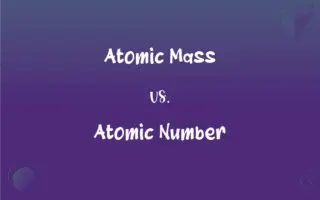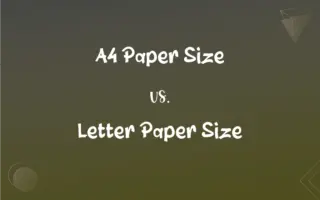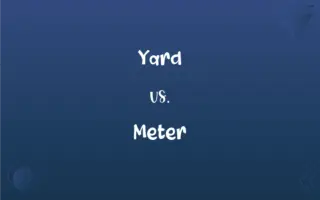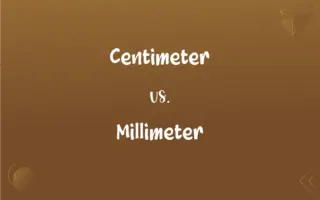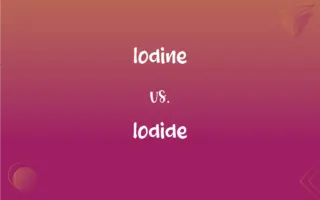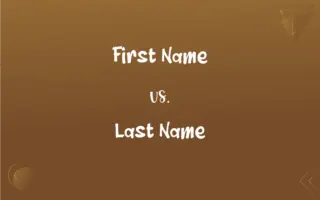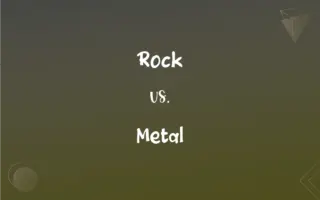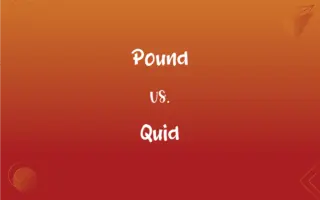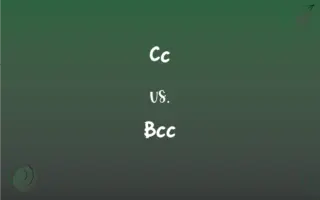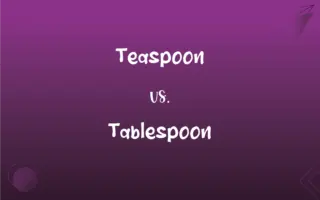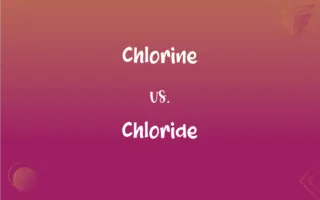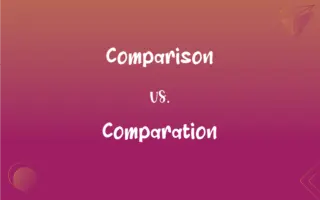Capacitor vs. Inductor: What's the Difference?
Edited by Aimie Carlson || By Harlon Moss || Updated on October 18, 2023
A capacitor stores energy in an electric field between conductive plates, while an inductor stores energy in a magnetic field around a coil.
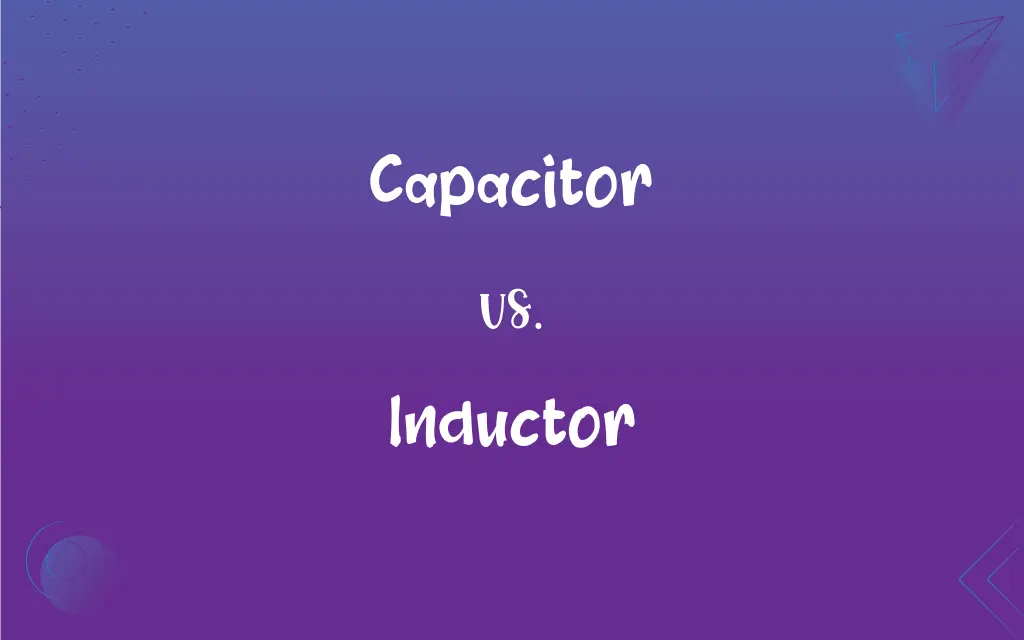
Key Differences
A capacitor is a device that has the primary function of storing energy in an electric field created between two conductive plates. In contrast, an inductor works on the principle of storing energy in a magnetic field, which is generated around a coil or wire when current flows through it.
Capacitors tend to oppose a change in voltage, making them vital components in smoothing voltage fluctuations in circuits. Inductors, on the other hand, resist changes in current, proving useful in filtering applications where current stabilization is desired.
In terms of their impedance in AC circuits, capacitors offer a high resistance (or reactance) at low frequencies and low resistance at high frequencies. In contrast, inductors behave oppositely, with high reactance at high frequencies and low reactance at low frequencies.
The energy stored in a capacitor is given by the formula 0.5 * C * V^2, where C represents the capacitance and V is the voltage across the capacitor. For an inductor, the stored energy is given by 0.5 * L * I^2, where L stands for inductance and I denotes the current flowing through the inductor.
While capacitors find extensive use in tuning circuits, timing applications, and voltage stabilization, inductors are prominently featured in transformers, motors, and chokes, primarily leveraging their ability to counteract rapid changes in current.
ADVERTISEMENT
Comparison Chart
Principle
Stores energy in electric field
Stores energy in magnetic field
Response
Opposes change in voltage
Opposes change in current
AC Reactance
High at low frequencies, low at high frequencies
Low at low frequencies, high at high frequencies
Typical Use
Tuning circuits, voltage stabilization
Transformers, motors, chokes
Capacitor and Inductor Definitions
Capacitor
Used to smooth or filter voltage in circuits.
To prevent voltage spikes, a capacitor was added to the setup.
ADVERTISEMENT
Inductor
A device that opposes changes in current flow.
He noticed the inductor was essential for the circuit's frequency response.
Capacitor
A device for accumulating and holding a charge.
He replaced the faulty capacitor in the radio.
Inductor
A component that introduces inductance in a circuit.
The inductor was wound tightly to achieve the desired inductance value.
Capacitor
Two plates separated by an insulator for charge storage.
The capacitor held its charge even after the power was turned off.
Inductor
A coil that stores energy in a magnetic field.
The inductor in the power supply filters the output.
Capacitor
An element that opposes voltage changes.
The flashing light's timing relies on the capacitor's charge and discharge rate.
Inductor
Used to transform one voltage level to another.
The step-down transformer utilized an inductor to reduce the voltage.
Capacitor
A component that stores electric energy.
The capacitor in the circuit maintains a steady voltage.
Inductor
A coil or winding that exhibits the property of inductance.
The inductor's core material enhanced its magnetic field.
Capacitor
An electric circuit element typically consisting of two metallic plates separated and insulated from each other by a dielectric, used to store charge temporarily or to filter signal frequencies. Also called condenser.
Inductor
A device that functions by or introduces inductance into an electric circuit.
Capacitor
(electronics) An electronic component capable of storing electrical energy in an electric field; especially one consisting of two conductors separated by a dielectric.
Inductor
The chemical reactant that initiates or accelerates an induced reaction and is consumed in the process.
Capacitor
A device used in electronic circuits to hold electrical charge, consisting of two conducting plates separated by a nonconducting (dielectric) medium; it is characterized by its capacitance.
Inductor
(electronics) A passive device that introduces inductance into an electrical circuit.
Capacitor
An electrical device characterized by its capacity to store an electric charge
Inductor
(medicine) an evocator or an organizer
Inductor
The person who inducts another into an office or benefice.
Inductor
That portion of an electrical apparatus, in which is the inducing charge or current.
Inductor
An electrical device that introduces inductance into a circuit
FAQs
How does an inductor store energy?
An inductor stores energy in a magnetic field around its coil.
What is a capacitor's primary function?
A capacitor primarily stores energy in an electric field.
Can capacitors and inductors work together?
Yes, they can work together, especially in filters and oscillatory circuits.
What happens when a capacitor fails?
A failed capacitor might not hold a charge, leading to circuit malfunction.
What materials are used for capacitor plates?
Capacitor plates can be made of metal foils like aluminum or tantalum.
What unit is used for inductance?
The unit of inductance is the Henry (H).
Do inductors have resistance?
Yes, inductors have a resistance due to the wire they're wound from.
Why are capacitors used in power supplies?
Capacitors smooth out voltage fluctuations in power supplies.
In which devices are inductors commonly found?
Inductors are found in transformers, motors, and chokes.
What's the unit of capacitance?
The unit of capacitance is the Farad (F).
How do inductors affect AC signals?
Inductors can either allow or oppose AC signals based on their frequency.
How can capacitors affect circuit timing?
Capacitors can introduce time delays due to their charge and discharge rates.
Can a capacitor block DC current?
Yes, capacitors block DC current and allow AC to pass.
What's a common use for capacitors in digital circuits?
In digital circuits, capacitors are often used for decoupling.
How can capacitors affect sound quality in audio systems?
Capacitors can influence frequency response and transient behavior in audio systems.
Are there any safety concerns with large inductors?
Large inductors can store significant energy and pose a risk if rapidly discharged.
Why might an inductor get warm?
An inductor might get warm due to resistance and core losses.
Can capacitors and inductors have polarity?
While most capacitors don't have polarity, electrolytic capacitors do. Inductors generally don't have polarity.
Can inductors work in radio-frequency circuits?
Yes, inductors are essential components in radio-frequency circuits.
Why are inductors used in audio circuits?
Inductors filter out high-frequency noise in audio circuits.
About Author
Written by
Harlon MossHarlon is a seasoned quality moderator and accomplished content writer for Difference Wiki. An alumnus of the prestigious University of California, he earned his degree in Computer Science. Leveraging his academic background, Harlon brings a meticulous and informed perspective to his work, ensuring content accuracy and excellence.
Edited by
Aimie CarlsonAimie Carlson, holding a master's degree in English literature, is a fervent English language enthusiast. She lends her writing talents to Difference Wiki, a prominent website that specializes in comparisons, offering readers insightful analyses that both captivate and inform.

